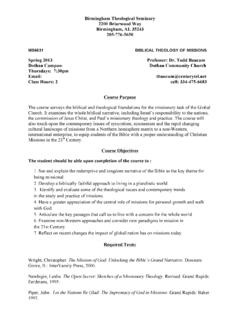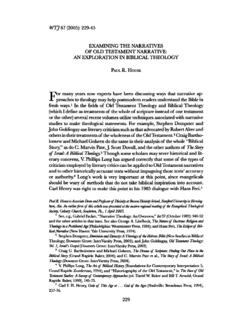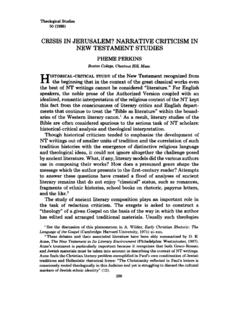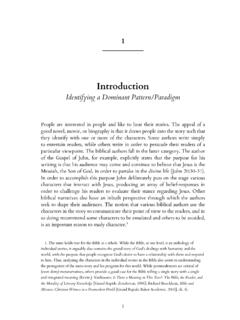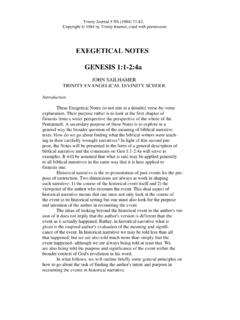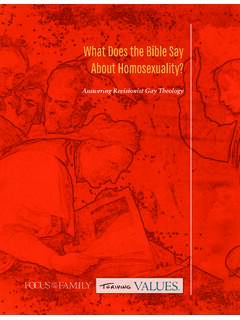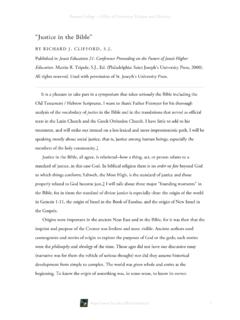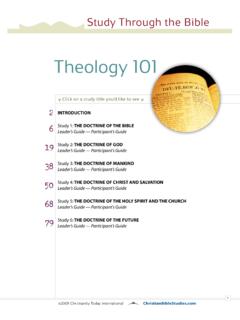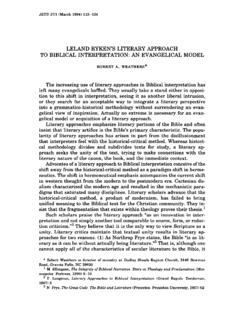Transcription of Observation of a Biblical Passage Page 2 - Balboa …
1 Biblical hermeneutics Observation of a Biblical Passage I. Observation is the first step of Bible study. A. Observation finds the facts about the Passage without evaluating their meaning or significance. B. Two main types of Observation : 1. Overview of the whole Biblical book (this gives you context for your study of a Passage ). 2. Details in a Passage of Scripture II. Basic steps of Observation of a Passage A. Pray (Ps 119:18). 1. Ask God to open your eyes to see the truth in His Word. 2. Ask Him to keep you from getting in a rut. B. Select a complete thought section ( pericope ) to study. 1. Don't study isolated verses. You can misunderstand by reading a statement out of context. 2. A thought section generally runs from 4-25 verses. It may be one paragraph or several. 3. A thought section deals with one main idea or if several ideas, there is a natural transition to a new section.
2 A. 1 Corinthians 12: spiritual gifts b. 1 Corinthians 13: the nature of love c. 1 Cor 1:18-31: God's wisdom contrasted with man's foolishness d. Hebrews 11: examples of faith e. James 3:1-12: the righteous use of the tongue (several aspects of speech). f. James 3:13-18: wisdom (clearly shifts to a new subject). C. Familiarize yourself with the context. 1. Read the whole book through, preferably in one sitting. 2. Consider making a book overview chart. D. Read your Passage through several times. 1. The goal of the first reading is to get the big picture. 2. Then read a few more times looking more carefully at details. E. Write down everything you see. 1. One of the best study aids is a pencil and paper 2. Writing things down helps you: a. Concentrate b. See more c. Remember more (impresses it on your senses). d. Retain a permanent record of what you learn Copyright 2017 Dr.
3 Harry A. Hahne Observation of a Biblical Passage Page 2. 3. List every detail you can see, no matter how trivial it appears. 4. It often helps to set it aside and pick it up the next day. You often see more the second time. See the story of the student and fish (see Finzel, Observe, Interpret, Apply, pp. 20-22 or Jensen, Independent Bible Study, pp. 173-178). F. Avoid interpreting at this stage. 1. You probably do not have enough information to interpret effectively yet. 2. If an interpretation pops into your head, write it down on a separate sheet of paper. Use it as a possible hypothesis to be tested later after you finish gathering observations. III. Asking observational questions can help you find important details A. The right questions can be like a shovel that digs into a Passage : 1. Who? Who are the people involved? 2. What? What does it say about the people?
4 What events happened? What ideas are expressed? What comes before and after the Passage ? What important words are used? What verb tenses are used? 3. Where? Where does the action take place? 4. When? When did the events take place? When did a particular event occur in relation to other events? 5. How? How are things accomplished? How well? How quickly? B. Cautions: 1. Let these questions help you see what is in the Passage , but don't limit your observations to the answers to these questions. 2. Avoid why questions which cannot be answered by a direct statement in the Passage . Most why . questions are interpretive questions. IV. Some important details to look for in the Observation stage A. Literary type (genre). 1. Some major literary types: a. Letter (Romans). b. Historical narrative (1 Chronicles). c. Gospel d. Poetry (Psalms). e. Prophecy (Isaiah). f. Apocalypse (Rev.)
5 4-22). g. Proverb h. Speech (Acts 17:22-31). i. Parable (Mt 13). j. Prayer (Dan. 9:4-19). Observation of a Biblical Passage Page 3. k. Legal literature (most of Leviticus). 2. A book may have multiple genres. Paul's letters contain hymns (Phil. 2:5-11) and prayers (Eph 3:16- 21). Revelation is mostly an apocalypse, but it contains 7 letters (ch 2-3). 3. The type of literature determines how you interpret a Passage . You should interpret a parable differently than a narrative and a poem differently than a letter. B. Important terms 1. Repeated words emphasize major ideas and help show the theme (Heb 11: faith; Rom 8: Spirit). a. The same or a related idea may be expressed in different words: announce, proclaim; son, child b. Look for different parts of speech from the same root (true, truth). This is more obvious in Greek and Hebrew than in translation: pistis (faith) pisteu (believe).
6 2. Look for terms that seem central to the teachings of the Passage . 3. Unusual terms may be significant to the theme. 4. Words that are typical of the author, but are rarely used by other Biblical authors, can reflect the author's style and special interests. C. Structural details 1. Structural details show the overall flow of the argument and the relationship of ideas. 2. A literal translation is particularly helpful for showing these structural details. The NASB is particularly good. The NIV often removes many of these structural devices to make the translation easier to read. 3. Repeated words at key places a. Inclusion: a word or idea is repeated at the beginning and ending of a section or sentence. (1) Ps 103 begins and ends with praise the Lord . (2) Ps 145: most stanzas of the poem are indicated by a repeated word at the beginning and end ( 1-2: praise; 3-6: great/greatness; 7-9: goodness/good; 11-13 kingdom).
7 B. Chiasm: repetition of a series of words, clauses or ideas with the repeated elements arranged in reverse order the second time. This creates an A-B-C-C'-B'-A' pattern or any number of levels deep. (1) Is 22:22. when he opens, no one will shut when he shuts, no one will open (2) Ps 51:3-11. A blot out B wash me C clean me D I know E I have sinned E' in sin D' teach me C' I will be clean Observation of a Biblical Passage Page 4. B' wash me A' blot out c. This structuring device is especially common in poetry, but may be used in prose. 4. Connective words (also called conjunctions). a. Connective words join ideas or sentences. b. They serve as road signs to the flow of the author's thoughts and logic. They often point to structural relationships, such as cause and effect or contrast. c. Some important connectives (adapted from Traina, Methodical Bible Study): Temporal or chronological Contrast -after (Rev 11:11) -although (Rom 1:21).
8 -as (Acts 16:16) -but (Rom 2:8). -before (John 8:58) -much more (Rom 5:15). -now (Lk 16:25) -nevertheless (1 Cor 10:5). -then (1 Cor 15:6) - sometimes = logical -otherwise (1 Cor 14:16). -until (Mk 14:25) -yet (Rom 5:14). -when (Jn 11:31). -while (Mk 14:43). -since - sometimes = logical Local or geographical Comparison -where (Heb 6:20) -also (2 Cor 1:11). -as (Rom 9:25). (Rom 5:18). -just (Rom 11:30-31). -likewise (Rom 1:27). -so also (Rom 4:6). Logical Series of facts 1. Reason -and (Rom 2:19). -because (Rom 1:25) -or 2 Cor 6:15). -for (Rom 1:11) -first of all (1 Tim 2:1). -since (Rom 1:28) - sometimes = temporal -last of all ( Cor 15:8). 2. Purpose -in order that (Rom 4:16) Condition -so that (Rom 5:21) - sometimes = result -if (Rom 2:19). 3. Result -so (Rom 9:16) - sometimes = purpose -then (Gal 2:21) - sometimes = temporal -therefore (1 Cor 10:12) Emphasis -thus (1 Cor 8:12) -indeed (Rom 9:25).
9 -so that (Matt 8 24) - sometimes = purpose -only (1 Cor 8:9). 5. Contrasts: association of opposite words or ideas (1 Thess 1:9: idols/true God; Heb 3:15-18: rich/poor; blind/see; cold/hot). Observation of a Biblical Passage Page 5. 6. Comparisons: point out the similarities between two things a. Simile: A direct comparison with as , like , just as .. so also (John 3:14: as Moses lifted up the snake in the desert, so the Son of Man will be lifted up). b. Metaphor: An implied comparison. Often it requires interpretation to identify metaphors. (Luke 13:32: Jesus calls Herod a fox, indicating his craftiness). 7. Result or cause and effect: (1 Th 1:6-7--The Thessalonians welcomed the gospel with joy in spite of suffering so that they became a model to all the believers in their area). 8. Purpose (Jn 3:16--God sent his Son so that whoever believes in Him would have eternal life).
10 9. Particularization: move from general principle to particulars (Heb 11--general principles about faith, then many examples of people of faith). 10. Generalization: move from particulars to general principle (James 2--moves from a case of favoritism to the principle that if you break one point of the law you are guilty of it all). 11. Interchange: alternate back and forth between 2 ideas (Nah 1: the Lord's judgment and the Lord's goodness). 12. Climax: builds gradually to a strong concluding emphasis (Rom 8:38-39--climax of 8:31-39 and to some extent of Rom 1-8--nothing can separate us from God's love (after a list of things that cannot). D. Grammatical details 1. Verb tense ( past, present and future). 2. Verb voice a. Active: subject performs the action of the verb ( John hit the ball ). b. Passive: subject receives the action of the verse ( the ball was hit by John ).)




